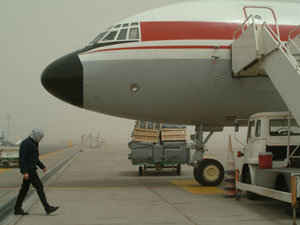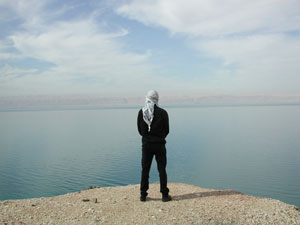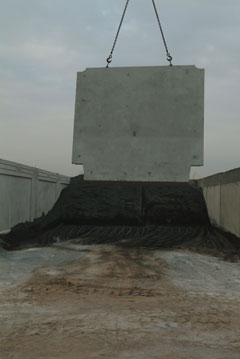Originally printed in the March/ April 2007 issue of Afterimage
Posted: June 10, 2007
 Going home for many awakens nostalgic feelings and fond memories of childhood. But for the Palestinian, the identity of home is often highly contested. Many Palestinians who have lived within the region or who have ties to the area often feel displaced as they struggle with notions of national identity and strive to retain their heritage. In his psychologically and politically charged photographs, Tarek Al-Ghoussein addresses issues of identity, displacement, and obstruction while referring to his Palestinian roots and the psychological impact of not being allowed within the borders of Palestine.
Going home for many awakens nostalgic feelings and fond memories of childhood. But for the Palestinian, the identity of home is often highly contested. Many Palestinians who have lived within the region or who have ties to the area often feel displaced as they struggle with notions of national identity and strive to retain their heritage. In his psychologically and politically charged photographs, Tarek Al-Ghoussein addresses issues of identity, displacement, and obstruction while referring to his Palestinian roots and the psychological impact of not being allowed within the borders of Palestine.
In his ongoing “Self Portrait” series begun in 2002, Al-Ghoussein presents images of a solitary figure wearing a kaffiyeh (a traditional Palestinian headdress), walking in front of such places or objects as an airplane, ship, or waterfront. These images are not documents of actual occurrences but rather renderings of constructed events. Nevertheless, these photographs conjure up images of terrorism for many post-9/11 viewers. In a 2004 interview, Al-Ghoussein stated that he wants to use the kaffiyeh in different situations to see how people react to these various scenarios in order to reference the many times Palestinians are depicted in the media and “how we are being represented as terrorists.” He finds this “frustrating [because] it is the only aspect that is being portrayed”(1) and continues, “I wanted to question people’s perceptions and previous conceptions of the Palestinians.”(2)
Al-Ghoussein, whose parents are Palestinian exiles, was born in Kuwait in 1962. Due to his father’s work, he lived in different locales such as the United States, Morocco, and Japan during his childhood. He received his undergraduate degree in photography from New York University and a Masters degree from the University of New Mexico. He currently teaches at American University of Sharjah in the United Arab Emirates. Before entering into academia he was a photojournalist and has exhibited internationally at such venues as Aperture Gallery in New York City; the Museum of Modern and Contemporary Art in Bonn, Germany; and the Royal Museum of Photography in Copenhagen, Denmark.
 When he began the “Self-Portrait” series, Al-Ghoussein did not realize that his imagery would be so politically charged until his motives for having his picture taken beside the Dead Sea (with Palestine in the far distance), wearing a kaffiyeh, were questioned by a police officer. Innocently, Al-Ghoussein, who was struck by the beautiful scene, set-up his camera on a tripod, composed the shot, and then had his friend take the picture, Untitled 2 (Self Portrait Series) (2003). However, while taking the photograph, a Jordanian police car pulled up beside his automobile, unbeknownst to Al-Ghoussein and his colleague, and observed the event. When the two headed back to the car, the police officer began to question Al-Ghoussein. He was taken to the police station and questioned for twenty-two hours. According to Al-Ghoussein, the police: “asked me what was I doing, who was I, why was I wearing the Palestinian scarf, why that particular scarf—not the red scarf or the other type of black scarf? And it just made me realize how charged that scarf was. And how much, even in the Middle East, it has become almost a symbol of terrorism. I guess that just made me realize it’s not just a symbol in the West, it’s become a symbol in the Middle East as well.”(3)
When he began the “Self-Portrait” series, Al-Ghoussein did not realize that his imagery would be so politically charged until his motives for having his picture taken beside the Dead Sea (with Palestine in the far distance), wearing a kaffiyeh, were questioned by a police officer. Innocently, Al-Ghoussein, who was struck by the beautiful scene, set-up his camera on a tripod, composed the shot, and then had his friend take the picture, Untitled 2 (Self Portrait Series) (2003). However, while taking the photograph, a Jordanian police car pulled up beside his automobile, unbeknownst to Al-Ghoussein and his colleague, and observed the event. When the two headed back to the car, the police officer began to question Al-Ghoussein. He was taken to the police station and questioned for twenty-two hours. According to Al-Ghoussein, the police: “asked me what was I doing, who was I, why was I wearing the Palestinian scarf, why that particular scarf—not the red scarf or the other type of black scarf? And it just made me realize how charged that scarf was. And how much, even in the Middle East, it has become almost a symbol of terrorism. I guess that just made me realize it’s not just a symbol in the West, it’s become a symbol in the Middle East as well.”(3)
At the time of the taking of this photograph, Al-Ghoussein had been grappling with his interest in the series. This key event made him realize that the series was significant to his cultural production.
At the 2003 Sharjah Biennial in the United Arab Emirates, the series of large 2- x 3-meter photographs were back lit by light boxes hung on the wall. Al-Ghoussein remarks, “It was a play on advertising and the light box is a traditional advertising tool. It was also a play on being in the light. I was trying to play with metaphors, one could say, or symbols within the medium.” In Al-Ghoussein’s work and within the gallery context, the language of mass media is reappropriated and transformed to create an environment where the viewer can question and challenge the stereotype of the Palestinian.
However, when taken out of the gallery context, his work has created a different kind of meaning that shows how prescient it is. While participating in the 2004 Noorderlicht International Photography Exhibition in the Netherlands, his photograph Untitled 5 (Self Portrait Series) (2003), which depicts a man wearing black with his head wrapped in a kaffiyeh walking toward a parked jet, was reproduced in black and white for publicity purposes in the newspaper de Volkskrant. The head of the local TV station VPRO-TV assumed another hijacking had occurred when he came across the image in the newspaper. After he realized the photograph had been misconstrued because of its context, the station executive produced a short documentary on viewers’ interpretations of the photograph within the context of the newspaper. In the program, all of the responses by Dutch nationals indicated that it might be a photo of a terrorist. In Sharjah, where Al-Ghoussein resides, viewers had mixed reactions. Some felt that the image probably represented terrorists while others thought that the figure was “protecting his head from the sand” or “going to clean the plane.” However, in most cases throughout the discussion in the documentary, the issue of terrorism did come into the conversation.
At the end of the documentary, a dialogue between the interviewer and Al-Ghoussein ensues:
Interviewer: Why do you portray yourself as a terrorist?
Al-Ghoussein: Am I a terrorist?
Narrator: Aren’t you?
Al-Ghoussein: No. Just a man dressed in black with his head wrapped in a scarf.
Through this interaction, it is clear that Al-Ghoussein understands how mass media reinforcement can create stereotypical cultural interpretations, a primary issue that he wants the viewer to question and challenge. Rather than countering the stereotype, he purposefully presents an image of it while inviting the viewer to explore a range of interpretations. For example, one may interpret the figure, at first glance, as a terrorist. But if one looks closely at the posture of the figure walking, he walks as though he is humble rather than defiant, which after initial determination may alter the interpretation of the photograph—reinforcing Al-Ghoussein’s argument.
Al-Ghoussein states, “with the ‘Self Portrait’ series, I think [the photographs] touch upon very sad issues. I think for so long the Palestinian Arabs were always represented as the troublemakers and the terrorists. It’s only just recently in the media you start to see people looking at opposite sides.”
His 1992 trip to photograph the Palestinian refugee camps in Jordan played an important role in his current work. The black-and-white documentary style photographs presented life in the refugee camps. However, Al-Ghoussein did not feel that the work captured the entire situation. He reflects, “For me, the work didn’t address the deeper aspects of the Palestinians or the psychological aspects of being a refugee. I think those images, because of the immediacy of the photograph, deals much more with the economic aspects of the situation.” With the “Self Portrait” series he feels that he has been able to better capture the plight of the Palestinian by working in a more conceptually abstract manner and moving away from a documentary style of photography. By integrating himself into his performative-based photography, the work became more personal and subjective. Al-Ghoussein is both the photographer and the photographed—similar to Cindy Sherman’s approach. Al-Ghoussein states, “My identity is hidden … you don’t know that it’s me. It’s just a figure wearing black with a scarf on. So, it’s not me as Tarek Al-Ghoussein, but me playing a Palestinian.” By wearing the kaffiyeh, an icon of defiance against tyranny for the Palestinian, Al-Ghoussein identifies his heritage but denies his personal identity with his face hidden from the viewer, which allows for a much broader and poetic reading.
.More recently he has begun to take himself out of the picture and use the landscape to express other aspects of the Palestinian plight. He has created a series of photographs that depict walls or barriers in a desert landscape. These images are not necessarily documents of found walls or obstructions but rather carefully choreographed images. In his artist statement he writes:
The “Untitled A and B Series” are both concerned with barriers, land, longing and, ultimately, belonging. It is an extension of themes I have been exploring for the past few years. During the process leading to these images, it became increasingly clear to me how barriers, land, longing, and “identity” inform, shape and define each other.(4)
 For example, the photograph Untitled 8 (B Series) (2005) depicts an outdoor corridor that has concrete barriers on both sides. A mound of dark soil is blocking the viewer from seeing beyond. A permanent obstruction of concrete is slowly being lowered by chains wedging into the mound of dirt—constricting the audience from seeing or moving beyond their current position. For Al-Ghoussein, this may be a reflection upon his own experiences with Palestine because he is not allowed within the parameters of the area known as Palestine. Al-Ghoussein writes, “As I attempt to come to terms with the issues related to my personal experience as a Palestinian-Kuwaiti [who] has never lived within the borders of Palestine, it has become apparent that this current body of work seeks to transcend the obvious reference to the unethical “defense barrier” being constructed in Palestine. The “walls” and “mounds” that appear throughout the images also speak of my own individual struggles irrespective of the conventional notions of national identity.”(5)
For example, the photograph Untitled 8 (B Series) (2005) depicts an outdoor corridor that has concrete barriers on both sides. A mound of dark soil is blocking the viewer from seeing beyond. A permanent obstruction of concrete is slowly being lowered by chains wedging into the mound of dirt—constricting the audience from seeing or moving beyond their current position. For Al-Ghoussein, this may be a reflection upon his own experiences with Palestine because he is not allowed within the parameters of the area known as Palestine. Al-Ghoussein writes, “As I attempt to come to terms with the issues related to my personal experience as a Palestinian-Kuwaiti [who] has never lived within the borders of Palestine, it has become apparent that this current body of work seeks to transcend the obvious reference to the unethical “defense barrier” being constructed in Palestine. The “walls” and “mounds” that appear throughout the images also speak of my own individual struggles irrespective of the conventional notions of national identity.”(5)
The installation using photographs from the “B Series” (2004–5) was created for the “Ideal City/Invisible Cities” exhibition in Zamosc, Poland in 2006. Al-Ghoussein was given a subterranean corridor with an arched ceiling and textured concrete surface at an old bastion. Al-Ghoussein hung eleven large photographs printed on rice paper so that the images could be seen from both directions. Photographs were carefully placed throughout the space so that the viewer had to walk past one to view another—creating physical obstacles for the patron. Al-Ghoussein states, “I set up the images about a meter and a half apart, so you had to navigate through the room to get into the back.… You had to walk through the walls.”
In a sense, Al-Ghoussein, who has never been to Palestine, is the cultural worker that Cornel West has described, calling upon artists and critics, “of the new cultural politics of difference to cast their nets widely, flex their muscles broadly and thereby refuse to limit their vision, analyses and praxis to their particular terrains. The aim is to dare to recast, redefine and revise the very notions of “modernity,” “mainstream,” “margins,” “difference,” “otherness.” We have now reached a new stage in the perennial struggle for freedom and dignity.… We look to the past for strength, not solace; we look at the present and see people perishing, not profits mounting; we look toward the future and vow to make it better and different.”(6)
The medium of photography is most appropriate for Al-Ghoussein’s work because of photography’s close relationship to such media as photojournalism. When asked if he felt that his work would create social change, Al-Ghoussein replied that he felt a person, “has to speak [his or her] mind, even if it’s not going to affect change … Whether [one] can affect change or not, that’s another issue, but it’s important enough for me just to say it.”
Although for Al-Ghoussein the opportunity to go “home” may not be available in the near future, his work, which has allowed him to discover his roots and articulate his beliefs, helps others understand and be sensitized to the psychology and issues of displacement that a Palestinian exile may endure.
NOTES
1. VPRO-TV Amsterdam (Producer), Documentary Segment on the Palestinian photographer Tarek Al-Ghoussein, Aired October 17, 2004. Video; also available via the Internet: www.vpro.nl/programma/ram/ afleveringen/18952106/.
2. Ibid.
3. All quotes by Al-Ghoussein, unless otherwise noted, are from an author interview with the artist, December 2006.
4. Al-Ghoussein, Artist Statement 2006 (provided by the artist).
5. Ibid.
6. Cornel West, “The New Cultural Politics of Difference” in Out There: Marginalization and Contemporary Cultures (Cambridge, Massachusetts: MIT Press, 1990), 39.